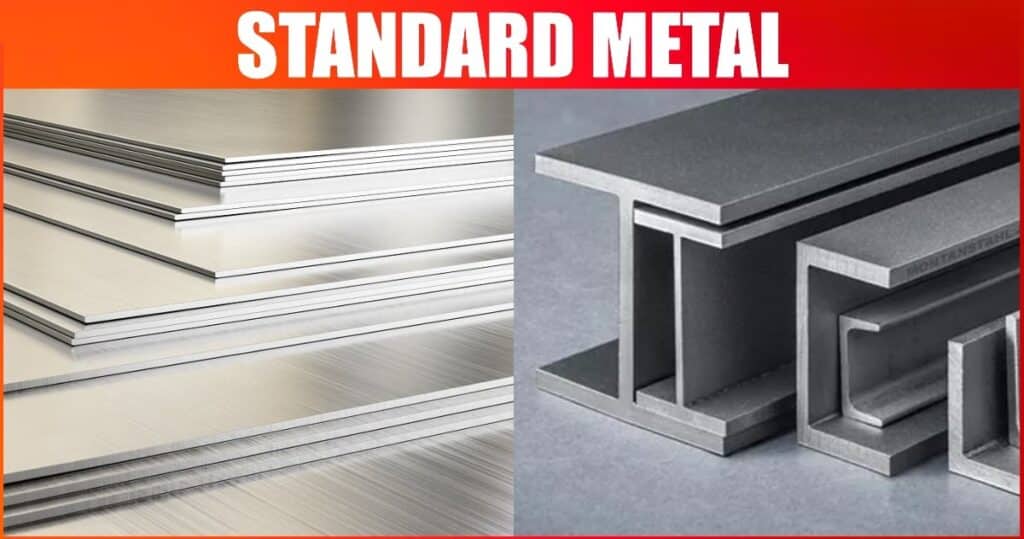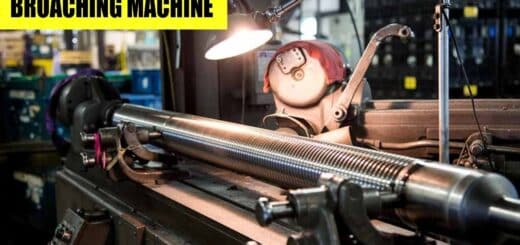Standard Metal: Definition, Components, Characteristics, Testing, Selection & Advantages

Standard Metal Introduction:
Standard Metal: Definition, Components, Characteristics, Testing, Selection & Advantages: – A metal is a strong material that is typically hard, and shiny, and features great electrical and thermal conductivity. Industrial metals are by and large moldable and that implies they are equipped for being hammered or twisted into various shapes without breaking or cracking; fusible capable of being liquefied by heat; and flexible ready to be drawn out into a thin wire. Iron is mainly composed in the ferrous group of metals. At the point when carbon, a non-metal is added to iron, the outcome is a common alloy known as steel. Metals have additionally been widely utilized as medical implants.
Stainless steel and titanium alloys are usually utilized in biomedical gadgets, for example, joint replacement parts, while gold, silver, and platinum are in many cases utilized in dentistry. Steel alloys may likewise have limited quantities of different metals or elements added, for example, manganese, nickel, chromium, silicon, titanium, tungsten, and so on, to give them the required properties. Regularly utilized non-ferrous metals incorporate aluminum, copper, silver, and gold.
What are Standard Metals?
Metal is combined with either one more metal or nonmetal ingredient to form a standard metal. To create a standard metal, the components are regularly melted, combined as one, and permitted to cool to room temperature. Many pure metals, such as gold’s softness, contain inherent traits which make them unsuitable for some applications. In any case, metals can acquire strength and other improved chemical characteristics by combining them to form an alloy.
By making a standard metal, other desired characteristics might be improved or added like hardness, machinability, and corrosion resistance. Metal standards serve to promote understanding and communication between metal producers and users, including processors, fabricators, and distributive merchants, and accordingly work with trading products of the metal business.
Standards are documented willful agreements that lay out significant criteria for products, services, and processes. Standards help to ensure products and services are good for their purpose and that they are practically identical and viable.
What is the Information Contained for Standards for Metals?
The designation system for metal materials and alloys, Important nominal dimensions, resilience on dimensions and shape tolerances, by and large through references to appropriate dimensional standards, the scope of inspection and testing, testing, test methods for the verification, and the relevant assessment and test techniques for the verification of determined properties, most frequently utilizing references to appropriate test standards, marking of the products.
What are the Different Components of Standard Metal?
Standard Metal’s discerning designers give incredible consideration to selecting the best and generally appropriate material for component construction. As a central aspect of component design and vital to creating products that carry out their function securely and successfully, a thorough understanding of the key chemical, mechanical, and metallurgic properties of metal and metal alloys, and how those properties change because of processing and environmental exposure, is required.
Factors that Influence Material Selection
Chemical properties, mechanical properties, cost, accessibility, compatibility with other system components, reliability, and appearance. While sourcing metals, it is of basic significance to have a uniform and consistent method for assuring metal properties meet the desired performance qualities from production lot to production part, one service center to the following one.
Characteristics of Standard Metal
- A few widely recognized organizations set standards that determine the material, chemical, mechanical, and metallurgical properties of metal materials.
- These standards are generally utilized by refineries, metallurgical labs, and manufacturers and provide a means for assuring a consistent grade of metal or alloy from a producer and a uniform methodology for quality and integrity testing.
- A clear definition of material properties is essential for all users all through the supply chain.
- Metal producers use standards to develop the correct formulations, and process parameters and determine dimensional and tolerance necessities for their production.
- Engineers use them to select the most ideal metal for a project, both as far as its manufacturability and its end use.
Below are a Few Characteristics Defined in a Metal Standard
- Compressive and tensile strength, ductility, hardness, toughness, fatigue strength, and corrosion resistance.
- These attributes can vary or fluctuate broadly between various kinds of metals and alloys. Even within one category, they can vary by the grade of material.
- Manufacturers or Producers utilize the properties illustrated in standards to survey the suitability of the material for use in at least one metalworking, fabrication, or machining processes that will be applied during manufacture of component.
- Some processes may require the metal to withstand high compressive forces, while others, such as in the case of wire forming, require a material with a high tensile strength that can be easily stretched.
- Manufacturers must also base material selection on end-use customer requirements.
- Numerous industries, like aviation and automotive, determine that a specific standard-grade metal be utilized in the construction of a component, and manufacturers depend on the ability to handily procure materials that are in compliance with those requirements. The obvious and comprehensive definition of a metal grade likewise eliminates the risk of errors underway because of a lack of complete specifications.
Advantages of Standard Metal
1. Strong Mixtures of Positive Qualities
Standard metals are combinations of different metals that retain good characteristics while excluding unwanted ones. Subsequently the compound is durable or sturdy than its pure metal parent. Since pure metals are oftentimes brittle, they are combined to form standard metals which produces materials that are stronger and more useful. In contrast to pure metal, where the molecules are all something very similar, standard metals have various atoms.
Subsequently, the atoms in standard metal have a harder time moving around, making them typically a lot stronger and harder than pure metals. By utilizing standard metals, one can construct more stronger buildings or create more stronger products.
2. Workable and Easily Adaptable
Compared to pure metals, standard metals are also more adaptable. Standard metal allows for further modifications and the enhancement of specific qualities that are more preferred in different applications of workable material. Standard metals combine the best characteristics of various materials while pure metals just hold back their inherent characteristics, whether good or bad. In contrast to pure metals, standard metals give more prospects for various projects.
3. Built to Withstand Corrosion
Standard metals are combinations and compounds of several metals and non-metals. While pure metals are chemically reactive and easily corroded, standard metals can be created to endure corrosion. Metals can be immediately destroyed by corrosion, which makes repairs expensive. Since the corrosion resistance of standard metals is often substantially higher than that of pure metals, standard metals help in delaying and forestalling this ongoing corrosion issue.
What are the Testing Standards for a Metal?
Metal standards and Testing standards Material testing Metal standards also reference the testing standards that should be applied for the inspection, analysis, and assessment of the metal’s composition and execution properties for quality assurance.
Standards are frequently utilized by mills and metallurgical research centers to decide the specific mechanical properties of a production lot and evaluate its conformance to the material specification.
- The test standards characterize the material condition at the time of testing, sampling frequency, and reporting requirements.
- Material testing Standard metals additionally reference the testing standards applied for the inspection, analysis, and assessment of the metal’s creation and execution properties for quality confirmation.
- Norms are regularly utilized by plants and metallurgical research facilities to decide the particular mechanical properties of a creation parcel and assess its conformance to the material determination.
- The test standards or guidelines characterize the material condition at the time of testing, sampling frequency, specimen location, revealing necessities, and other test parameters.
- By and large, more than one test standard should be applied to check conformance. Material testing necessities are comprehensive and typically include chemical analysis as well as metallurgic review and assessment of the metal’s grain size and structure.
- Mechanical property testing utilizes different methods for measuring the ductility, strength, hardness properties, and fracture sturdiness, and may likewise include measurement of characteristics related to torsion, shear, bending, and weakness, with extra measurements of creep behavior in instances of elevated temperature materials.
- A salt spray or shower test is likewise utilized for the assessment of corrosion resistance. Conformance to a standard is assured through certification reports.
- A certified plant test report, likewise referred to as mill certification or metallurgical test report is a quality confirmation document utilized in the metals industry that ensures a material’s chemical and physical properties.
- It likewise affirms that a product made of metal complies with a set of explicit standards. This document is generated by the raw material manufacturer and provides companies at all levels of the supply chain with certification that the material received matches the prerequisites of the standards set out in their request.
- It provides full detectability of the material from its initial commencement to its consideration in a finished part. Standard test techniques can likewise be utilized for different purposes, for example, incoming material acceptance testing by the buyer or evaluation of parts after service exposure.
- Standard metals make a significant contribution to the development and production of industrial and consumer items, equipment, and machines, and are vital for the deregulation of metal products all through the supply chain.
- As well as laying out a comprehensive test of standards for product execution to ensure the product is good for its purpose, they likewise ensure that processors, fabricators, and wholesalers receive products that have comparable composition and key performance attributes.
Conclusion
Metals analyzers assume a vital role in deciding the chemical composition of metal, which, in combination with physical and mechanical properties, is critical in determining its suitability and quality. Analysis of the standard metal, as well as the active one, at any time in the production process, is an essential step toward being mindful to satisfy quality standards. It very well may be expensive and time-consuming to stay aware of the prevalent plenty of standards and be familiar with their equivalent manually. Also, finding a suitable grade by application is hard.
Nowadays, manufacturers are making metals of a more extensive territory, and control standards, and quality assurance must be highly vigorous. Investigation of the incoming materials and the active products is an imperatively essential shield for the utilization of metals in the assembling processes. In spite of being ingenious, the result of even 3D metal printing will just rely upon the quality of the raw input. This will render reviewing a fundamental part of the process.
Content Source: – continentalsteel, totalmateria
Image Source: – montanstahl













